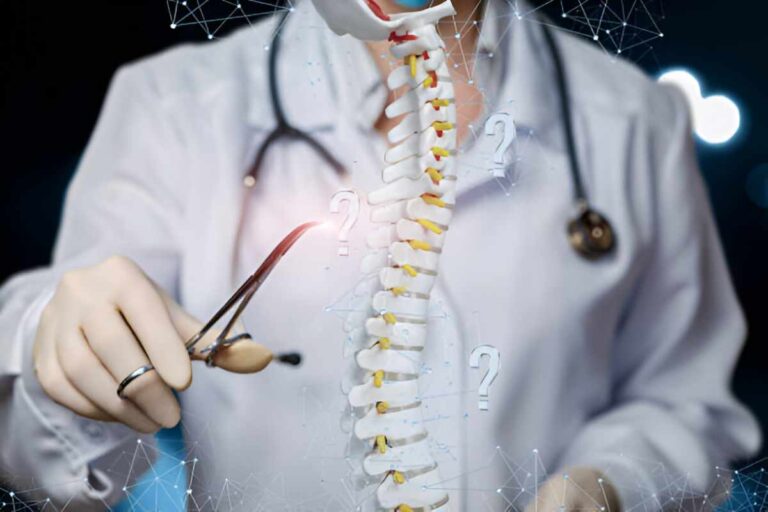Spinal Surgery: Indications, Risks, and Recovery
Most of us have had back pain at some point in our lives. Sometimes it’s due to sitting for long periods at a desk, slouching over our computers, or straining a muscle while lifting something. But when the pain doesn’t go away and affects our everyday life, it could be an indication of a serious issue. The spine, both literally and figuratively, is the backbone of the body. It helps us to walk, stand, and even protects the nerves of our body that control everything from sensitivity to muscle power. When relief through non-surgical interventions such as rest, drugs, and physiotherapy becomes challenging, specialists suggest spinal surgeries. In this blog we’ll go through the symptoms, risks, and recovery process of spinal surgery to keep you informed.
Table of Contents
Understanding Spinal Surgery
Spine surgery isn’t always an option. It’s saved for the case when the other non-surgical measures such as pain medication, physical therapy, dietary limitation, or steroid injection don’t work. The primary objectives of spinal surgery are nerve decompression, stabilization of the spine, and the removal of deformity. There are various operations:
- Discectomy: Removal of part of a herniated disk compressing upon a nerve.
- Laminectomy: Removal of bone or ligament to give more space within the spine canal.
- Spinal Fusion: Joining two or more vertebrae to restrict painful motion.
- Artificial Disc Replacement: A replacement implant for a damaged disc.
- Minimally Invasive Surgery: Minuscule incisions and precise instruments for less recovery time.
Indications for Spinal Surgery
The indications of the spine injury vary with the severity of the injury. Some common indications of the spine injury are as follows:
1. Chronic Neck or Back Pain
Persistent back pain for weeks or months that does not go away after any form of non-operative treatment may be the sign of spine issues. Surgery is required when disc damage, spurs, or instability are diagnosed by imaging studies. Pain that restricts usual daily activities such as bending, climbing stairs, or even sleeping undisturbed is typically a symptom that more assistance is required.
2. Herniated or Slipped Disc
Bulging disc is a condition where the soft center of the spinal disc compresses against the adjacent nerves. It may cause stabbing, shooting pain, paralysis or numbness in the arms or legs. It is managed with surgical decompression and restoring function. In children and younger adults, this is one of the most common spine problems because of sudden jerks or wrong posture.
3. Spinal Stenosis
Spinal stenosis is the narrowing of the spinal canal due to aging, arthritis, or hypertrophic ligaments. Walking becomes harder due to constant aches. Surgery creates space to ease the nerves and reduce the pain.
4. Spinal Deformities
Scoliosis or kyphosis creates some curvature with pain. Bracing or physiotherapy is useless, and corrective surgery is a solution to straighten the backbone. These surgeries not only reduce pain but also improve body posture and confidence
5. Spinal Fractures or Injuries
Trauma, breakage, or a fall may sometimes badly injure the spine. To stabilize the area and avoid further complications surgery may be needed.
6. Neurological Symptoms
The most significant reasons are neurological. Numbness, sudden bowel or bladder incontinence, or gradual weakness are red-flag signs. The symptoms indicate compression of the nerves, and immediate surgery is always the only solution.
Risks Involved in Spinal Surgery
Spinal surgery has certain risks that you should be aware of to avoid any complications. Some of them are mentioned below:
1. General Surgical Complications
Infection, bleeding, and anesthetic complications are the general risks during surgery. Even though they sound serious, most of them are managed well in good hospitals. Adequate infection control by the hospital reduces these complications.
2. Surgery Specific Risks
- Damaged Nerve: It is not so common but it can cause numbness or weakness.
- Failed Back Surgery Syndrome: Persistent pain after operation in certain patients.
- Spinal Fluid Leakage: May cause headaches, but is typically tolerable.
- Implant Complications: When rods or screws are inserted, they will occasionally move or break.
3. Risk Increasing Factors
There are some factors that increase the risk after surgery. Elderly patients, diabetic patients, smokers, or obese patients have an increased chance of risk after surgery. These risks are rendered minimal through proper pre-surgical screening.
Recovery After Spinal Surgery
After a surgery, recovery is based on the type of surgery done, the patient’s health, and following rehabilitation protocols.
1. Early Post-Operative Phase
Most of the patients are kept in the hospital for two days post-surgery. Pain is controlled by medication, and early movement of the patient is encouraged. In minimally invasive surgeries the hospital stay is usually a day or two.
2. Rehabilitation and Physiotherapy
Physiotherapy is the way to recover faster. It focuses on improving the flexibility and muscle strength. Customized therapy according to individual needs provides relief to the patients to gain mobility in a safe manner.
3. Lifestyle Changes
There are some changes which need to be followed by the patients:
- Heavy weight lifting should be avoided.
- Proper sitting and standing posture should be maintained.
- Body weight should be controlled.
- Work activity and daily activities should be resumed gradually.
Conclusion
Spinal surgery becomes life-changing for patients with chronic pain, nerve compression, or acute spine-related conditions. While it involves some risk, the improvement of medical technology and expert professionals has made it less risky and more effective. The determining factor is timely consultation, proper diagnosis, and the best treatment plan. People looking for the best treatment and guidance should visit Paras HMRI. They have expert ortho specialist in Patna who offer end-to-end spine treatment from diagnosis to surgery, all under one roof.
Take the first step towards recovery with Paras HMRI today.


